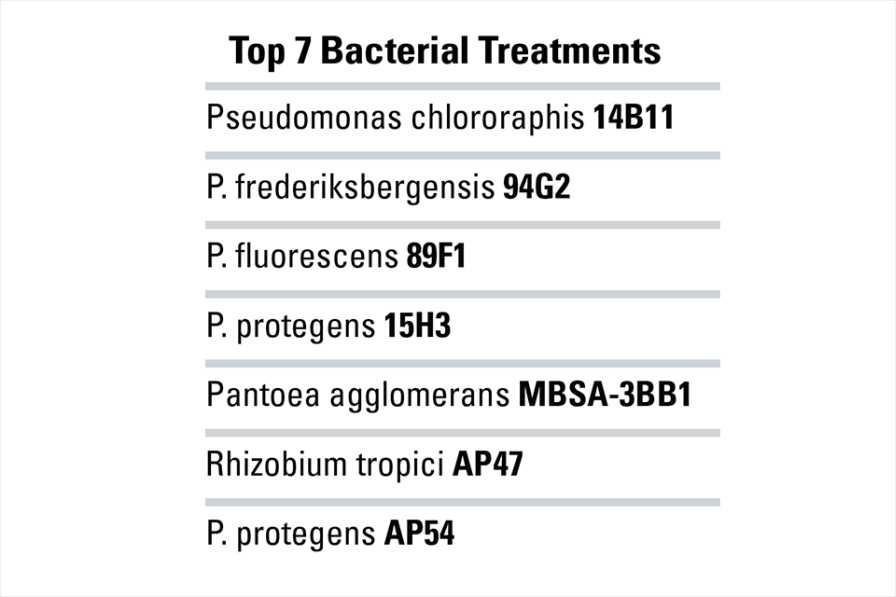How to Rid Your Greenhouse Crops of Botrytis Blight

Botrytis blight can be pain for plants like petunias in the greenhouse.
Photo: Kaylee South
When you think of biocontrol, your first thought may be of using natural enemies to control insect populations. But biocontrol is not limited to releasing beneficials to control invertebrate pests. Biocontrol can be used to control a wide range of pests, including insects, mites, weeds, and plant diseases. Biological pesticides, whose active ingredients are live microorganisms (usually fungi or bacteria) or their metabolites (different chemicals that they produce during their growth), are referred to as microbial biological control agents, or MBCAs.
Everything You Ever Wanted to Know About MBCAs
MBCAs control plant pathogens and protect plants from disease using a variety of different mechanisms or modes of action. These include:
- Hyperparasitism
- Antibiosis
- Induced resistance
- Competition
MBCAs can be antagonists that directly inhibit or kill the pathogen by hyperparasitism, or antibiosis. Parasitism is a direct interaction between the MBCA and the pathogen, in which the MBCA uses the pathogen for nutrients. Hyperparasitism refers specifically to the interaction where a parasite (the MBCA) is infecting another parasite (the plant pathogen). MBCAs can also directly inhibit pathogen growth by producing and excreting antibiotics or other toxins. This is referred to as antibiosis.
Some MBCAs do not have any direct interactions with the pathogen, but they induce resistance responses within the plant. The presence of the MBCA turns on biochemical pathways in the plant that are involved in defense against pathogens and prevent or reduce disease symptoms. Other MBCAs inhibit pathogens by out-competing them for space or nutrients or modulating other environmental conditions that negatively impact the growth and success of the pathogen.
Improved efficacy can be obtained when biopesticides contain multiple microorganisms with different modes of action. This makes it less likely for pathogens to develop resistance. MBCAs often include fungi from the genus Trichoderma and bacteria from the genera Bacillus and Pseudomonas.
How We Calculated Disease Severity
Botrytis cinerea, the causal agent of botrytis blight, is one of the most common and economically devastating pathogens of greenhouse crops due to its wide host range. It can infect plants and cause losses during greenhouse production as well as during shipping and retailing. Cool temperatures, high humidity, reduced air movement, and wet flowers and leaves are conducive to B. cinerea infection. B. cinerea has developed resistance to many chemical fungicides, so MBCAs provide a good option for improving disease control.

Disease severity rating scale (0/Shows no symptoms to 7/flower died because of B. cinerea) used to evaluate flowers after B. cinerea inoculation.
Photos by Kaylee South
A collection of 60 beneficial bacteria was evaluated to identify MBCAs for B. cinerea in greenhouse bedding plants. Beneficial bacteria were sprayed onto the leaves and flowers of Petunia × hybrida ‘Carpet Red Bright,’ and the potting media was drenched every two weeks for six weeks starting at transplant. Cease (BioWorks), a biofungicide containing Bacillus subtilis QST 713, was used as the positive control, and a treatment with no bacteria was used as the negative control.
After the final bacterial treatment, plants were inoculated with B. cinerea. All open flowers at the time of B. cinerea inoculation were rated daily for 12 days using a disease severity rating scale from 0 (flower shows no symptoms) to 7 (flower died because of B. cinerea). The daily ratings were then used to calculate the overall disease severity for each petunia using a disease severity index.
What Works
The calculated disease severity index for each rating day was used to select the top seven performing strains (listed below) from the original collection of 60 strains.

Petunias treated with these bacterial strains or Cease had reduced disease severity compared to petunias that received no bacterial treatment. Six days after inoculation with B. cinerea, petunias treated with the Pseudomonas strain 94G2 had a 59% reduction in the disease severity index, while petunias treated with Cease had a 42% reduction. By day 12, petunias treated with the Pseudomonas strain 14B11 had the highest reduction in the disease severity index (50%), and Cease-treated petunias had a 29% reduction in disease severity.
We have identified seven beneficial bacterial strains that show promise as MBCAs for B. cinerea in greenhouse bedding plant production. Research is ongoing to determine if combining the bacteria can improve botrytis blight control. Based on greenhouse trials and gene sequencing data, we plan to combine bacteria with different modes of action to improve the efficacy of these MBCAs. Including MBCAs in a disease management program provides options to chemical control that may reduce the incidence of pesticide resistance. The identification of new biocontrol bacteria will provide additional resources for greenhouse disease management.









